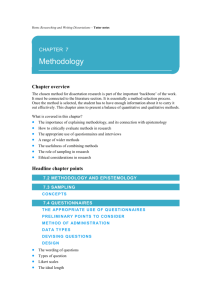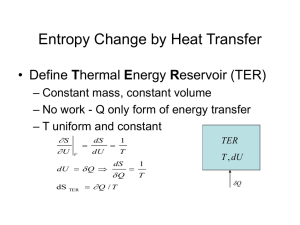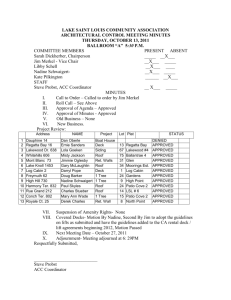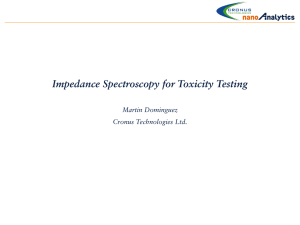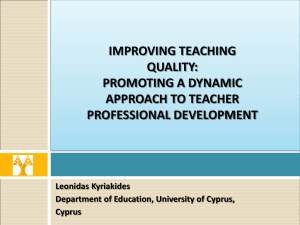economic commission for europe
advertisement
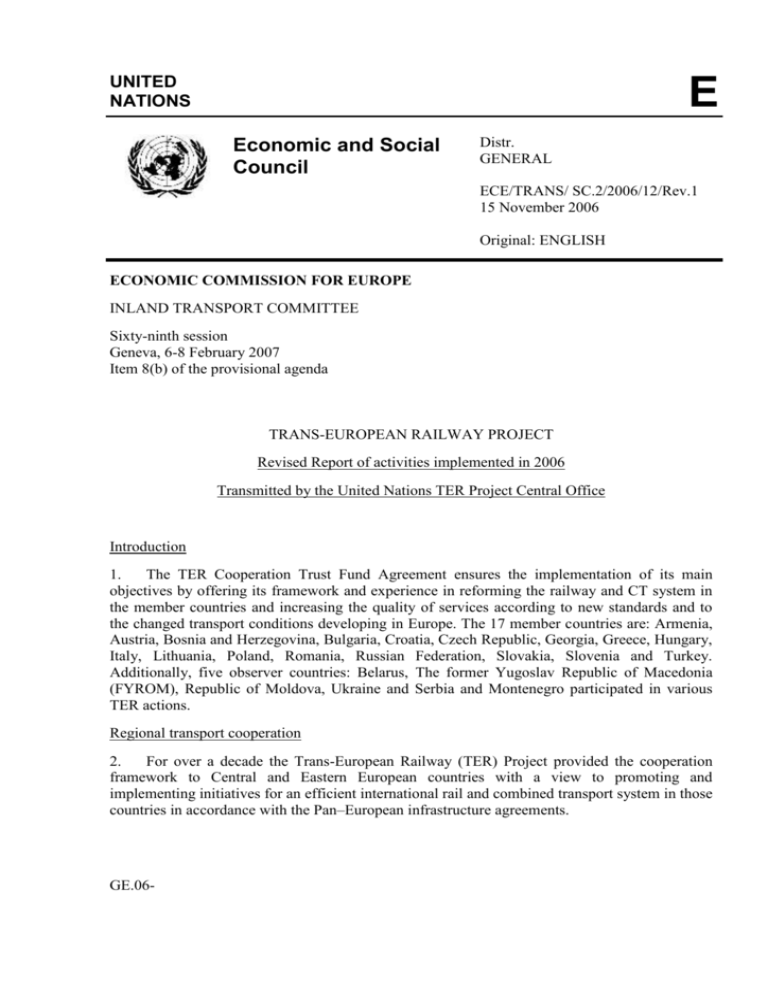
UNITED NATIONS E Economic and Social Council Distr. GENERAL ECE/TRANS/ SC.2/2006/12/Rev.1 15 November 2006 Original: ENGLISH ECONOMIC COMMISSION FOR EUROPE INLAND TRANSPORT COMMITTEE Sixty-ninth session Geneva, 6-8 February 2007 Item 8(b) of the provisional agenda TRANS-EUROPEAN RAILWAY PROJECT Revised Report of activities implemented in 2006 Transmitted by the United Nations TER Project Central Office Introduction 1. The TER Cooperation Trust Fund Agreement ensures the implementation of its main objectives by offering its framework and experience in reforming the railway and CT system in the member countries and increasing the quality of services according to new standards and to the changed transport conditions developing in Europe. The 17 member countries are: Armenia, Austria, Bosnia and Herzegovina, Bulgaria, Croatia, Czech Republic, Georgia, Greece, Hungary, Italy, Lithuania, Poland, Romania, Russian Federation, Slovakia, Slovenia and Turkey. Additionally, five observer countries: Belarus, The former Yugoslav Republic of Macedonia (FYROM), Republic of Moldova, Ukraine and Serbia and Montenegro participated in various TER actions. Regional transport cooperation 2. For over a decade the Trans-European Railway (TER) Project provided the cooperation framework to Central and Eastern European countries with a view to promoting and implementing initiatives for an efficient international rail and combined transport system in those countries in accordance with the Pan–European infrastructure agreements. GE.06- ECE/TRANS/ SC.2/2006/12/Rev.1 page 2 In this context it is worthwhile recalling the main specific objectives of the Trans-European Railway: To ensure the coordinated upgrading of infrastructure of the TER network to the AGC and AGTC standards. - To contribute to the modernization of rolling stock. - To help participating Governments in improving rail efficiency and the adaptation of the railway organization to market oriented management. - To develop a database on the railway and combined transport system in the region. - To coordinate the improvement of operation parameters and ameliorate the situation at the border crossings with a view to eliminating the bottlenecks in international rail transport. - To develop the cooperation among the member countries in the preparation of studies. - To promote the cooperation among the member countries in the field of combined transport. - To promote training activities for experts of the member countries. 3. Detailed information in relation to the above issues was presented at the Working Party on Rail Transport (SC.2) session in 2005. TEM and TER Master Plan 4. In September 2005, the TEM and TER Projects completed the elaboration of their Master Plan, including the identification of the backbone networks for road and rail transport in 21 Central, Eastern and South-Eastern European countries as well as a realistic investment strategy to gradually develop these networks. As many as 491 projects (319 TEM and 172 TER) with an aggregate estimated cost of EUR 102.10 billion, of which, EUR 49.55 billion for road and EUR 52.55 billion for rail, were evaluated and prioritized. These results had taken duly into account alternative scenarios of growth, methodological aspects and assumptions, bottlenecks and missing links as well as problems of funding of transport infrastructure and border crossings. 5. The TER Master Plan has been a major step forward in the future development of the rail transport infrastructure in Central and Eastern Europe and its interoperability. The TER Project Steering Committee approved the conclusions and recommendations of the Master Plan and concrete follow-up actions have been included in the Work programme of the TER Project. The collection of missing data, the presentation of the shape of the backbone networks in different time horizons and the review of the Master Plan by 2008 is among those actions. 6. The TEM and TER Master Plan was presented to the EU High Level Group chaired by Ms. de Palacio on 25 October 2005 and has been explicitly acknowledged in its final report. 7. The Final Report of the TEM and TER Master Plan including maps, conclusions and recommendations, is posted on the UNECE website, whilst a copy of the final publication of Master Plan will be made available to the participants of the SC.2. ECE/TRANS/SC.2/2006/12/Rev.1 page 3 8. In addition, the TEM and TER Master Plan Final Report was presented to the 68th session of the ITC, held in Geneva on 7-9 February 2006 and an advance copy of the report was distributed to the participants. The Committee welcomed the completion of this work, reiterated its support to this activity and invited the TEM and TER Projects, in close cooperation with the secretariat and the concerned countries, to proceed with the follow-up actions recommended by the Master Plan, including monitoring of its implementation, updating when necessary and appropriate, and the widest possible dissemination of the results of the TEM and TER Master Plan. The Committee also invited close cooperation between the European Commission, the secretariat and the TEM and TER Projects in the follow-up activities of the Master Plan and of the High Level Group. 9. Furthermore, following consultations with the EC DG TREN on the future implementation of the recommendations of the High Level Group and the TEM and TER Master Plan, held in Brussels in February 2006, it became apparent that there is a need for a comparison of the TEM and TER Master Plan Backbone networks with the five axes proposed by the HLG as well as with the legal commitments from the Accession Treaties and the Decision 884/2004/EC of the EU member countries involved in the Master Plan. 10. A project proposal for the “Facilitation of of implementation of TEM and TER Master Plan” was submitted by UNECE to the 14th OSCE Economic Forum held on 22-24 of May 2006 in Prague, for possible funding. On this occasion, 150 copies of the Master Plan were distributed to the participants during the Forum. TER Master Plan follow-up activities 11. Monitoring the implementation of the TER Mater Plan is a major priority for the TER Project. In this regard a number of activities have been undertaken by the TER project in the year 2006. These include: (a) TER Project, in cooperation with experts from its member countries and the support of external consultant elaborated a comparison report of the TER Master Plan Backbone network with the five axes proposed by the HLG as well as with the legal commitments from the Accession Treaties and the Decision 884/2004/EC of the EU member countries involved in the Master Plan. The results of this comparison will be presented to the participants of the SC.2. (b) A 1st Meeting of TER Experts for the Implementation of TER Master Plan was held in Baden, Austria, on 19 June 2006. The participants examined the current status of the TER backbone network and the progress of implementation of the projects identified by the Master Plan. They endorced a TER Action Plan for monitoring the implementation of the Master Plan and made a number of recommendations to the TER Steering Committee for approval. These include: Setting deadlines for provision of missing data and filling in the questionnaire by the countries involved in the Master Plan; proposals on the content, follow-up and timing of the elaboration of the comparison report of the TER Backbone network, with the EU HLG (II), TEN-T and the accession treaties; and proposals for the organization of two/three workshops till the end of 2006, for examining the progress achieved in the implementation of the priority projects, railway border crossing issues and funding questions of the Master plan. ECE/TRANS/ SC.2/2006/12/Rev.1 page 4 (c) A 2nd Meeting of TER Experts for the Implementation of TER Master Plan was held in Budapest, Hungary, 3-4 September 2006. The participants considerd the first draft comparison report of the TER Master Plan vis-à-vis the High Level Group No II, and the legal commitements of the EU member states from 2004 as well as those acceding to EU in 2007. They also considered the progress of the collection of missing data and the draft report on the progress of the implementation of the projects identified by the TER Master Plan and agreed on a number of recommendations on the implementation of the remaining activities for the TER Master Plan follow-up work till the end of 2006. (d) A 3rd such meeting is planned to be held in Geneva, on 14 November 2006, in order to consider the results of the TER work on the implementation of the folow-up activities in 2006 and make recommendations to the TER Steering Committee on the work plan of the TER Project in 2007, in this respect. (e) The TER Steering Committee will hold its 23rd session on 16 November 2007, in Geneva in order to consider, among other, the work done and the plan on the follow-up activities of the Master Plan in 2007. Other TER activities carried out in 2006 12. Parallel to the Master Plans work, the development of the TER Project was successfully continued during the reporting period. These include: (a) At its twenty-first session in Prague, Czech Republic, 14-16 November 2005, the TER Steering Committee, following the positive evaluation of the progress of the TER Project during the Project Cycle 2001- 2005 made by its member countries, agreed with the prolongation of TER Project in a new phase 2006-2010. (b) Upon receipt of official notifications from the Governments of Armenia and Azerbaijan in 2005, in which the two countries expressed their desire to join the TEM and TER Projects, and the completion of the established procedures, Armenia and Azerbaijan were accepted as parties to the TEM and TER Trust Fund Cooperation Agreements. (c) On 9 December 2005, the Ambassador of Armenia to the United Nations in Geneva signed the TEM and TER Trust Fund Cooperation Agreements. The accession of Armenia, Azerbaijan to TER will bring the total number of countries participating in TER 18. (d) Following the signing of Memorandum of Understanding (MoU), for cooperation between UNECE and UIC in the framework of the TER Project, several actions and events have been co-organized and discussions, for cooperation in the field of data collection and GIS mapping activities, as well as other fields of mutual interest, have been conducted. Following a similar path, the cooperation between the TER Project with other related organizations UIRR, Eurochambres, Europlatforms, etc. was promoted. (e) Negotiations with CEI have been concluded at the highest level to ensure closer cooperation between CEI and the TER Projects. Already, three events on railway transport border-crossing facilitation, were successfully co- organized and co-financed jointly by CEI– TER during the sixth, seventh and eighth CEI Summit Economic Forum in 2003,2004 and 2005, respectively. ECE/TRANS/SC.2/2006/12/Rev.1 page 5 13. In addition to the above the TER Project Managers attended a number of events and meetings organized / hosted by transport and railway authorities of its member countries as well as by other railway related European organizations and bodies. These include: - Railway meetings of ECMT and ECE (SC.2), in Paris, France, 9-11 January 2006; - Steering Committee of Pan-European Corridor IV and Steering Group Railways of the Pan-European Corridor IV in Vienna, Austria, 12-13 January 2006; - Workshop on Rail Border Crossing Practices in Southeastern Europe, in Sofia, Bulgaria, 21-22 March 2006; - 5th Preparatory Meeting for the International Conference on Facilitation of Railway Border Crossing in Warsaw, Poland, 28-30 March 2006; - Workshop on trans-shipment infrastructure of Cierna and Tisou Kosice, Slovakia, 19-21 April 2006; - Joint TER – Slovak Ministry of Transport Workshop on Border crossing and adoption of measures in line with the EU policy and new regulation regarding new Schengen borders, Cierna and Tisou Kosice, Slovakia; - Meeting on the Russian Federation/Italy Freight Corridor, in Vienna, Austria, 22 May 2006; - Round table on rail transport among the Ministries of the Czech Republic, Italy and Poland, UIC, Rail Net Europe, in Vienna, 22 May 2006; - Meeting on interoperability and border control facilitation, in Győr, Hungary, 29 May 2006; - Steering Committee Meeting, Corridor VI, in Graz, Austria, 1-2 June 2006; - Meeting on border crossing and infrastructure project Baltic Sea – Black Sea, Szczechin– Constanta, in Kosice, Slovakia, 8-9 June 2006; - Nineteenth session of the Working Party on Transport Trends and Economics (WP.5), in Geneva, Switzerland, 13-15 September 2006. 14. The Project Manager had also a number of important meetings with railway authorities of the TER member countries as well as international organizations and railway companies aimed at promoting the activities of the TER Project. These include meetings with: Mr. Kocourek, Vice- Minister of Transport of the Czech Republic; Mr. Gyula Gaál, President-General Director of MÁV; Mr. Csaba Siklós, General Director of GYSEV; Mr. Danail Nedialkov, Head of the Danube Commission Secretariat; Mrs. Maria Kadlecikova, Head of Mission of FAO in Budapest. ECE/TRANS/ SC.2/2006/12/Rev.1 page 6 Conclusions 15. All activities carried out in 2006 were in line with the Short-Term Strategy of TER, as well as with the Programme of Work adopted by the TER Steering Committee in 2006 in Baden, Austria. 16. The TER Master Plan has been a major contribution of the TER Project towards the future development of the rail transport infrastructure in Central and Eastern Europe and its interoperability. Monitoring the implementation of the TER Mater Plan is a major priority for the TER Project. 17. TER offers the advantage of gathering during its meetings both representatives of the Ministries of Transport and the railway companies from the member countries. 18. At the Governmental level, it is the only forum in the region approaching all the railway transport issues for a more rapid integration and at higher standards of the railway network of the TER member countries into the Western European network. It also stimulates measures for harmonizing the legislation of the Central and Eastern European countries to the Western European standards in order to ensure a higher quality of services all along the corridors and higher profitability of the railway sector in their countries. In order to implement the AGC/ AGTC standards in the region, as well as to improve the railway and combined transport services, the TER Project is a useful tool. ___________

